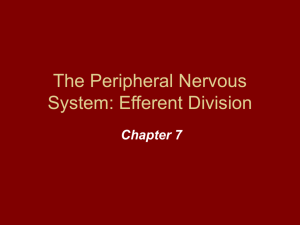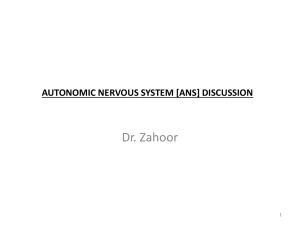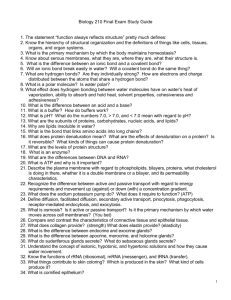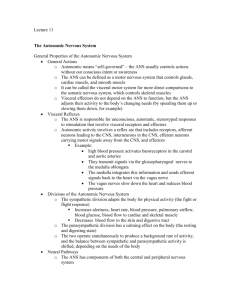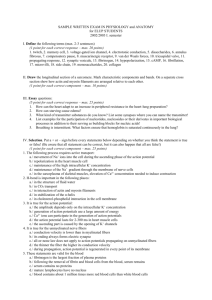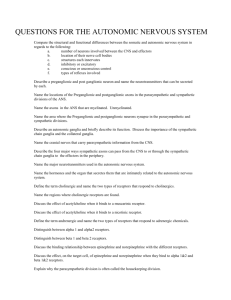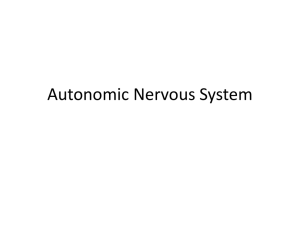19. Smooth Muscle
advertisement
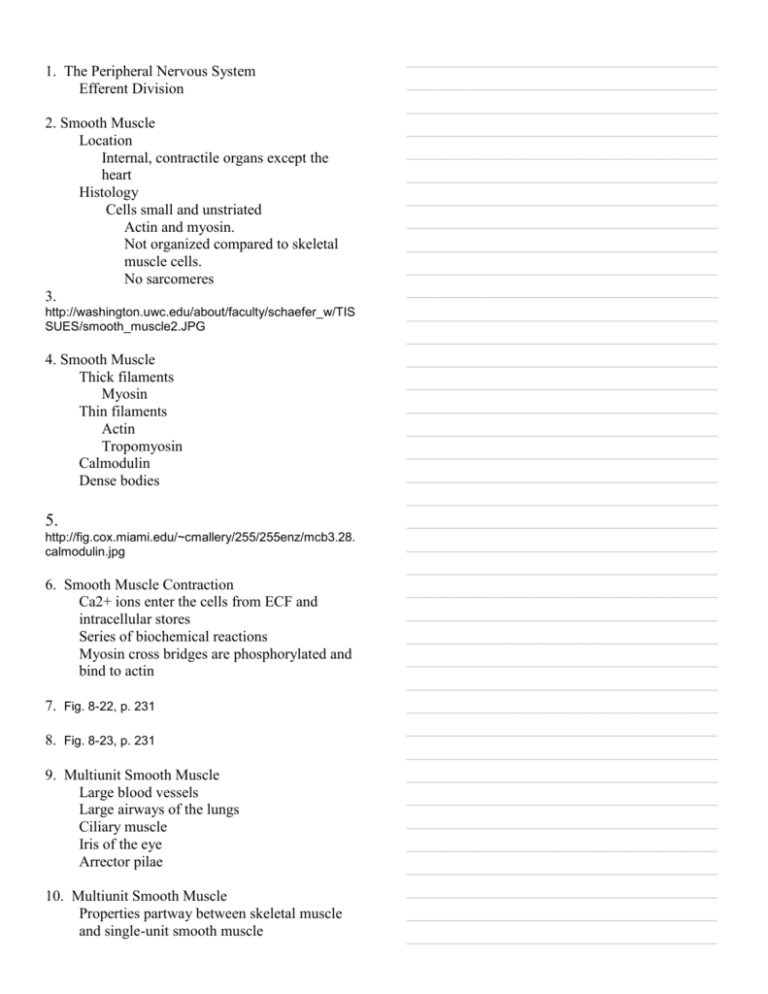
1. The Peripheral Nervous System Efferent Division 2. Smooth Muscle Location Internal, contractile organs except the heart Histology Cells small and unstriated Actin and myosin. Not organized compared to skeletal muscle cells. No sarcomeres 3. http://washington.uwc.edu/about/faculty/schaefer_w/TIS SUES/smooth_muscle2.JPG 4. Smooth Muscle Thick filaments Myosin Thin filaments Actin Tropomyosin Calmodulin Dense bodies 5. http://fig.cox.miami.edu/~cmallery/255/255enz/mcb3.28. calmodulin.jpg 6. Smooth Muscle Contraction Ca2+ ions enter the cells from ECF and intracellular stores Series of biochemical reactions Myosin cross bridges are phosphorylated and bind to actin 7. Fig. 8-22, p. 231 8. Fig. 8-23, p. 231 9. Multiunit Smooth Muscle Large blood vessels Large airways of the lungs Ciliary muscle Iris of the eye Arrector pilae 10. Multiunit Smooth Muscle Properties partway between skeletal muscle and single-unit smooth muscle _______________________________ _______________________________ _______________________________ _______________________________ _______________________________ _______________________________ _______________________________ _______________________________ _______________________________ _______________________________ _______________________________ _______________________________ _______________________________ _______________________________ _______________________________ _______________________________ _______________________________ _______________________________ _______________________________ _______________________________ _______________________________ _______________________________ _______________________________ _______________________________ _______________________________ _______________________________ _______________________________ _______________________________ _______________________________ _______________________________ _______________________________ _______________________________ _______________________________ _______________________________ _______________________________ _______________________________ _______________________________ _______________________________ _______________________________ Neurogenic Innervated by the autonomic nervous system 11. Single-Unit Smooth Muscle Hollow organs of digestive, reproductive, urinary systems and small blood vessels Form functional syncytia Syncytium is a group of interconnected cells When an action potential develops in one cell, it quickly spreads to other cells. Gap junctions Cells in syncyticium contract as single, coordinated unit 12. Single-Unit Smooth Muscle Myogenic Self-excitable muscle cells Unable to contract Does not require nervous stimulation Automatic shifts in ion concentrations in the ECF and ICF cause spontaneous depolarizations to threshold potential. pacemaker potentials slow-wave potentials 13. Fig. 8-24a, p. 232 14. Fig. 8-24b, p. 232 15. Table 8-4, p. 233 16. Single-Unit Smooth Muscle Rate and strength of contraction influenced by ANS Hormones Other factors All of these influences alter the level of calcium ions in the cells’ cytosol. 17. Fig. 8-25, p. 234 18. Gradations of Contraction Differs from skeletal muscle contraction. Depends on level of Ca2+ in cytosol. Many cells have enough calcium in the cytosol to maintain tone (low level of tension) in the absence of action potentials. 19. Smooth Muscle _______________________________ _______________________________ _______________________________ _______________________________ _______________________________ _______________________________ _______________________________ _______________________________ _______________________________ _______________________________ _______________________________ _______________________________ _______________________________ _______________________________ _______________________________ _______________________________ _______________________________ _______________________________ _______________________________ _______________________________ _______________________________ _______________________________ _______________________________ _______________________________ _______________________________ _______________________________ _______________________________ _______________________________ _______________________________ _______________________________ _______________________________ _______________________________ _______________________________ _______________________________ _______________________________ _______________________________ _______________________________ _______________________________ _______________________________ Exists at many lengths without a change in tension Develops tension even when stretched Connective tissue limits stretch Important for emptying hollow organs Contraction is slow and energy-efficient. 20. Autonomic Nervous System Innervates Cardiac muscle Smooth muscle Exocrine glands Endocrine glands ANS neurotransmitters Acetylcholine Norepinephrine Autonomic nerve pathway has two neurons Preganglionic fiber Postganglionic fiber 21. Autonomic Nervous System Subdivisions are sympathetic and parasympathetic nervous systems Sympathetic nerve fibers originate from the thoracic and lumbar levels of the spinal cord Parasympathetic nerve fibers originate from the cranial and sacral levels of the CNS 22. ANS - Function Involuntary responses of visceral organs Visceral organs receive dual innervation Input from both subdivisions of the ANS. Antagonism Usually both subdivisions are active in controlling the activity of an internal organ. Sympathetic or parasympathetic tone or activity 23. Exceptions Most innervated blood vessels (arterioles and veins) are innervated only by sympathetic fibers. Most sweat glands are innervated only by sympathetic nerves. Adrenal medulla – sympathetic 24. Fig. 7-3, p. 188 25. ANS Structure Autonomic nerve pathway has two neurons Preganglionic fiber Postganglionic fiber _______________________________ _______________________________ _______________________________ _______________________________ _______________________________ _______________________________ _______________________________ _______________________________ _______________________________ _______________________________ _______________________________ _______________________________ _______________________________ _______________________________ _______________________________ _______________________________ _______________________________ _______________________________ _______________________________ _______________________________ _______________________________ _______________________________ _______________________________ _______________________________ _______________________________ _______________________________ _______________________________ _______________________________ _______________________________ _______________________________ _______________________________ _______________________________ _______________________________ _______________________________ _______________________________ _______________________________ _______________________________ _______________________________ _______________________________ Sympathetic preganglionic fibers are short postganglionic fibers are long, terminating at effectors. Parasympathetic nerve fibers preganglionic fibers are long postganglionic fibers are short, terminating at effectors. 26. Fig. 7-1, p. 186 27. ANS Structure Ganglia Sympathetic Located near the spinal cord Sympathetic trunk or chain ganglia Parasympathetic Located near or in effector organs 28. Fig. 7-2, p. 187 29. ANS Neurotransmitters ACh Cholinergic fibers Parasympathetic and sympathetic preganglionic fibers Parasympathetic postganglionic fibers Norepinephrine Adrenergic fibers Sympathetic postganglionic fibers release noradrenalin (norepinephrine) 30. Cholinergic Receptors Bind ACh Nicotinic receptors Postganglionic cell bodies of all autonomic ganglia Muscarinic receptors Bind to Ach from parasympathetic postganglionic nerve fibers. 31. Adrenergic Receptors Bind to norepinephrine and epinephrine from sympathetic postganglionic fibers. Alpha 1 receptors Excitatory response in the effector Alpha 2 receptors Inhibitory response Beta 1 receptors Mainly in the heart Excitatory response Beta 2 receptors _______________________________ _______________________________ _______________________________ _______________________________ _______________________________ _______________________________ _______________________________ _______________________________ _______________________________ _______________________________ _______________________________ _______________________________ _______________________________ _______________________________ _______________________________ _______________________________ _______________________________ _______________________________ _______________________________ _______________________________ _______________________________ _______________________________ _______________________________ _______________________________ _______________________________ _______________________________ _______________________________ _______________________________ _______________________________ _______________________________ _______________________________ _______________________________ _______________________________ _______________________________ _______________________________ _______________________________ _______________________________ _______________________________ _______________________________ Inhibitory response 32. The Adrenal Glands Cortex Hormones Medulla Modified ganglion Releases Epinephrine (80%) Norepinephrine (20%) 33. Fig. 7-4, p.190 34. Sympathetic Responses pupils of the eye dilate sweating is promoted heart rate increases bronchioles dilate motility for digestion is inhibited liver: conversion of glycogen into glucose urination is inhibited Preparation for emergency or stressful situations. “Flight, fight or fright” 35. Sympathetic Effects Increases Cardiac output Pulmonary ventilation Blood flow to skeletal muscle Available energy Decreases Function of non-emergency systems Sympathetic system responds as a whole 36. Parasympathetic Responses Usually the opposite (e.g., decreased heart rate) or None (no activity of glucose production from the liver) Dominant during quiet, relaxed times “Rest and Digest” or “Feed and Breed” 37. Parasympathetic Effects Housekeeping Obtain nutrients and energy from food promote secretions and mobility of digestive tract Eliminate wastes Promotes urination and defecation _______________________________ _______________________________ _______________________________ _______________________________ _______________________________ _______________________________ _______________________________ _______________________________ _______________________________ _______________________________ _______________________________ _______________________________ _______________________________ _______________________________ _______________________________ _______________________________ _______________________________ _______________________________ _______________________________ _______________________________ _______________________________ _______________________________ _______________________________ _______________________________ _______________________________ _______________________________ _______________________________ _______________________________ _______________________________ _______________________________ _______________________________ _______________________________ _______________________________ _______________________________ _______________________________ _______________________________ _______________________________ _______________________________ _______________________________ Parasympathetic stimulation occurs “as needed” 38. Parasympathetic Review 39. Sympathetic Review 40. Comparison of Divisions 41. Interactions of ANS Divisions Dual innervation Dynamic antagonism Heart, respiratory, GI Tone Sympathetic – vascular system Parasympathetic – dominates heart, GI, GU Glands except adrenals and sweat glands Cooperation 42. Effects of ANS Stimulation 43. Effects of ANS Stimulation 44. Effects of ANS Stimulation 45. Effects of ANS Stimulation 46. Somatic/ANS Comparison Effectors Somatic Skeletal muscle ANS Smooth muscle Cardiac muscle Glands 47. Two Neuron Chain Preganglionic Primary Brain stem or spinal cord Ganglionic or postganglionic Postsynaptic or secondary Outlying ganglia Innervate target organs 48. Neurons Somatic CNS ANS Preganglionic CNS _______________________________ _______________________________ _______________________________ _______________________________ _______________________________ _______________________________ _______________________________ _______________________________ _______________________________ _______________________________ _______________________________ _______________________________ _______________________________ _______________________________ _______________________________ _______________________________ _______________________________ _______________________________ _______________________________ _______________________________ _______________________________ _______________________________ _______________________________ _______________________________ _______________________________ _______________________________ _______________________________ _______________________________ _______________________________ _______________________________ _______________________________ _______________________________ _______________________________ _______________________________ _______________________________ _______________________________ _______________________________ _______________________________ _______________________________ Ganglionic Ganglia 49. Neurotransmitters Somatic Acetylcholine Excitation ANS Preganglionic axon Acetylcholine Excitation Postganglionic axon Norepinephrine Excitation or inhibition _______________________________ _______________________________ _______________________________ _______________________________ _______________________________ _______________________________ _______________________________ _______________________________ _______________________________ _______________________________ _______________________________ _______________________________ _______________________________ _______________________________ _______________________________ _______________________________ _______________________________ _______________________________ _______________________________ _______________________________ _______________________________ _______________________________ _______________________________ _______________________________ _______________________________ _______________________________ _______________________________ _______________________________ _______________________________ _______________________________ _______________________________ _______________________________ _______________________________ _______________________________ _______________________________ _______________________________ _______________________________ _______________________________ _______________________________ _______________________________ _______________________________ _______________________________ _______________________________ _______________________________ _______________________________ _______________________________ _______________________________ _______________________________ _______________________________ _______________________________ _______________________________ _______________________________ _______________________________ _______________________________ _______________________________ _______________________________ _______________________________ _______________________________ _______________________________ _______________________________ _______________________________ _______________________________ _______________________________ _______________________________ _______________________________ _______________________________ _______________________________ Target organ /system Eye – Pupil Lens Glands (lacrimal, nasal, salivary, gastric, pancreatic) Sweat glands Adrenal medulla Arrector pili muscles Heart muscle Coronary blood vessels Bladder/urethra Lungs Digestive organs Liver Gallbladder Kidney Genitals – penis vagina/clitoris Blood vessels Blood coagulation Cellular metabolism Adipose tissue Mental activity Effects of ANS Stimulation Parasympathetic Sympathetic
